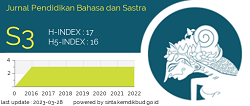Melacak Arti dan Makna Tarum, Tarumanagara, Ci Tarum, dan Pataruman melalui Pendekatan Linguistik, Sejarah, dan Budaya
Abstract
Keywords
References
Agustarini, R., Heryati, Y., Adalina, Y., Adinugroho, W. C., Yuniati, D., Fambayun, R. A., Sabastian, G. E., Hidayat, A., Tata, H. L., Ingram, W., & Perdana, A. (2022). The Development of Indigofera spp. as a Source of Natural Dyes to Increase Community Incomes on Timor Island, Indonesia. Economies, 10(2). https://doi.org/10.3390/economies10020049
Ajatrohaedi. (1991). Tjarita parahijangan: Naskah titilar karuhun urang Sunda abad ka-16 masehi. Bandung: Yayasan Nusalarang.
Bachtiar, T. (2007). “Ci Tarum, Kawasan Penghasil Pewarna Alami” dalam Pikiran Rakyat. Bandung.
Bachtiar, T. (2008). “Pada tahun 1914 Pengusaha Batik Protes Ingin Pewarna Buatan” pada Pikiran Rakyat.
Balfour-Paul, J., (1998). Indigo. London: British Museum Press.
Brown, R. (1811). The miscellaneous botanical works. Edinburgh.
Budiastuti, M. T. S., Pujiasmanto, B., Sulistyo, T. D., Nurmalasari, A. I., & Setyaningrum, D. (2020). Pemanfaatan Limbah Ekstraksi Indigofera tinctoria L. sebagai Pupuk Organik pada Usaha Batik Pewarna Alami di Sukoharjo. PRIMA: Journal of Community Empowering and Services, 4(2), 109. https://doi.org/10.20961/prima.v4i2.44 13
Cardon, D. (2007). Natural Dyes, Sources, Tradition, Technology and Science. London: Archetype Publications.
Casson, L. (1989). The periplus maris erythraei: Text with introduction, translation, and commentary. Princeton University Press.
Codes, J. (1975). The Indianized states of Southeast Asia (edited by Walter F. Vella, translated by Susan Brown Cowing. Australian National University Press, Canbera.
Erdawati, Lisdiana, H., & Saefurahman, G. (2023). Utilization of Indigofera Leaves as Natural Dyes for Silk Fabrics. IOP Conference Series: Earth and Environmental Science, 1187(1), 012014. https://doi.org/10.1088/1755-1315/1187/1/012014
Gafurovna, A.K., & Gulmira, U. (2021). Introduction and bioecological properties of indigofera (Indigofera tinctoria l) plant in the conditions of Surkhandarya region. Galaxy International Interdisciplinary Research Journal, 9(12).
Głowacki, E. D., Voss, G., Leonat, L., Irimia-Vladu, M., Bauer, S., & Sariciftci, N. S. (2012). Indigo and Tyrian purple - From ancient natural dyes to modern organic semiconductors. Israel Journal of Chemistry, 52(6), 540–551. https://doi.org/10.1002/ijch.201100130
Hardjasaputra, S. (2007). “Citarum dalam perspektif sejarah” dalam Pikiran Rakyat. Bandung: Padjadjaran, Fakultas Sastra, Jurusan Ilmu Sejarah.
Heras, E. (1931). The Pallava Genealogy
Studies in Indian History of the Indian Historical Research Institute. Bombay: St. Xavier's College.
https://kbbi.web.id/tarum
Kusumawardhana, G.T. & Harya, K.P. (2022). Bujangga Manik, Gunung Sembung, dan Hulu Citarum (editor: Chye Retty Isnendes). Bandung: Buana Varman Semesta.
Li, S., Cunningham, A. B., Fan, R., & Wang, Y. (2019). Identity blues: The ethnobotany of the indigo dyeing by Landian Yao (Iu Mien) in Yunnan, Southwest China. Journal of Ethnobiology and Ethnomedicine, 15(1), 1–14.
Marsden, W. (2012). Sejarah Sumatra. Cetakan ke-2. Depok: Komunitas Bambu. https://doi.org/10.1186/s13002-019-0289-0
Namirah, I., Affifah, I., Wijayanti, I. E., & Langitasari, I. (2019). Kajian Terhadap Tanaman Pewarna Alami Pada Masyarakat Baduy Luar. EduChemia (Jurnal Kimia Dan Pendidikan), 4(2), 204. https://doi.org/10.30870/educhemia.v4i2.6150
Noordyun, J., & Teeuw, A. (2006). Three old Sundanesse poems. Leiden. KITLV-LIPI.
Panitia Kamus LBSS. (1981). Kamus umum basa Sunda. Bandung: Penerbit TARATE.
Peng, L. H., Lin, Y. H., & Siswanto, I. (2021). Using interactive technology in visualized narration book as a medium to promote hakka blue-dyed in jhanghu community. Journal of Physics: Conference Series, 1833(1). https://doi.org/10.1088/1742-6596/1833/1/012051
Poerwadarminta, W.J.S. (1976) Kamus umum bahasa Indonesia. Jakarta: Pusat Pembinaan dan Pengembangan Bahasa (Departemen Pendidikan dan Kebudayaan), Balai Pustaka.
Prasetyo, F. A. (2020). Bandung dan Pemaknaan Dago dalam Sejarah: Masa Lalu, Masa Kini. Lembaran Sejarah, 15(1), 64. https://doi.org/10.22146/lembaran-sejarah.59525
Putri, P. G., Warsiki, E., & Sugiarto. (2019). The Stability of Extract Indigofera tinctoria for Color Indicator. IOP Conference Series: Earth and Environmental Science, 347(1), 8–13. https://doi.org/10.1088/1755-1315/347/1/012070
Suarbhawa, I.G.M., Sunarya, I.Ny., Sumerata, I.W., & Utami, L.S. (2013). Berita penelitian arkeologi: Prasasti Sukawana, Desa Sukawana, Kecamatan Kintamani, Kabupaten Bangli. Denpasar: Balai Arkeologi Denpasar.
Tello-Burgos, N., López-Montes, A. M., Ballesta-Claver, J., Collado-Montero, F. J., & Blanc García, M. D. R. (2021). Identification of Indigo Dye (Indigofera tinctoria) and Its Degradation Products by Separation and Spectroscopic Techniques on Historic Documents and Textile Fibers. Studies in Conservation, 66(1), 7–22. https://doi.org/10.1080/00393630.2020.1796019
Van Romburgh, P. (...) ‘On the formation of indigo from indigofera’s and from Marsdenia tinctoria’ dalam Jurnal Koninklijkke Nederlandse Akademie van Wetenschappen - Proccedings Series B Physical Sciences, Vol. 2, pp.344-348).
Vigesima Tercera Edicio. (2014). Anil in diccionario de la lengua espanola (Vigesima tercera edicio) in Real Academia Espanola. (2014)
Vinoth Kumar, J., Kavitha, G., Arulmozhi, R., Arul, V., & Abirami, N. (2021). Cyan color-emitting nitrogen-functionalized carbon nanodots (NFCNDs) from Indigofera tinctoria and their catalytic reduction of organic dyes and fluorescent ink applications. RSC Advances, 11(44), 27745–27756. https://doi.org/10.1039/d1ra04351j
Williams, M. (1851). Dictionary, English and Sanskrit. London: WM. H. Allen and Co.
Zhang, X., Good, I., & Laursen, R. (2008). Characterization of dyestuffs in ancient textiles from Xinjiang. Journal of Archaeological Science, 35(4), 1095–1103. https://doi.org/10.1016/j.jas.2007.08.001
DOI: https://doi.org/10.17509/bs_jpbsp.v23i2.68690
Refbacks
- There are currently no refbacks.
Copyright (c) 2024 Jurnal Pendidikan Bahasa dan Sastra
p-ISSN 1412-0712 | e-ISSN 2527-8312
JPBS is published by:
Fakultas Pendidikan Bahasa dan Sastra (Faculty of Language and Literature Education), Universitas Pendidikan Indonesia,
in cooperation with
TEFLIN, and APPBIPA


